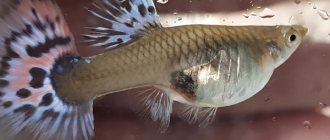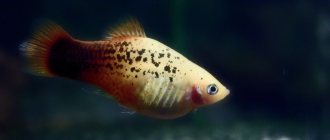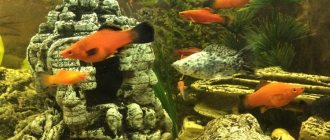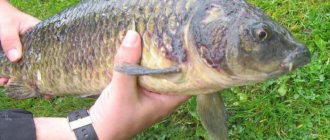Rainbow cichlasoma (lat. Cichlasoma synspilum) is a large, interesting fish. Of course, its advantage is its bright, attractive color. And the disadvantage is sometimes a violent, pugnacious disposition. I had a chance to observe an aquarium with a rainbow cichlasoma, in which she lived, a black pacu and a pair of labiatums. At the same time, even the black pacu, which was twice as large as the rainbow one, huddled forlornly in the corner.
Description
The rainbow is a large fish that can grow up to 35 cm in length and live up to 10 years. Although in the aquarium they all grow smaller in size. She has a powerful, strong, oval-shaped body; the male develops a fatty bump on his head.
It got its name for its bright color, from the head to the middle of the body it is bright purple, then yellow, sometimes black, with various splashes of other colors.
Moreover, as they grow older, the color only intensifies, and it sometimes takes up to 4 years to gain the brightest color.
Appearance
The red cichlid has a massive, round, tall body . The head is large with large eyes . The iris of the eyes is painted a beautiful turquoise color. The jaws are powerful, the lower one protrudes - “upper mouth”, which indicates that it feeds on food that only floats in the upper or lower layers of water. The lips are fleshy.
Rainbow cichlazoma has pronounced sexual dimorphism. The male is larger and brighter in color, he has a fatty formation on his head - a “bump”, and the dorsal and anal fins are much wider than those of the female. At their ends there is a kind of “braid”. All fins are transparent with a pale blue tint.
The color of the fish is remarkable, which explains the name – “rainbow”. The head is red or crimson in color. There is an intense pink spot on the throat. The body has zones of red, blue, green and yellow. The scales are cast with mother-of-pearl and have a thin black edging along the edge.
From the trunk of the caudal fin to the middle of the body there are black spots of different sizes, merging into a line. This line is characteristic of many species of the cichlid family. A scattering of small black spots may also be located under the long dorsal fin.
With age, the color becomes richer and brighter. Maximum color appears from the age of 3 years. There are many variations of color combinations. Rainbow cichlasoma has been used in the creation of multi-colored hybrid aquarium fish species.
Feeding
In nature, it feeds mainly on plant foods. Fruits, seeds, aquatic plants and algae are the basis of its diet. But in an aquarium they are unpretentious in feeding.
The basis of nutrition may well be food for large cichlids. Additionally, you can feed them with protein foods: shrimp, mussel meat, fish fillets, worms, crickets, etc. Be sure to feed with plant foods, for example, chopped zucchini or cucumbers and food with spirulina.
Diseases and prevention
The most common disease for the fish described is obesity. The best prevention is a strict feeding schedule, which is important to constantly adhere to.
Any aquarist will be glad to receive the rainbow cichlid in his collection. The interesting color of the fish, their peculiar behavior - all this attracts the attention of not only experienced breeders, but also novice aquarium enthusiasts. It is important to weigh all the pros and cons before purchasing the presented individual, so as not to be disappointed in the pet in the future.
Keeping in an aquarium
Since this is a very large fish, the minimum volume for keeping is 400 liters or more. The temperature for keeping rainbow cichlazoma is 24 - 30°C, but if you want the fish to be more active, then closer to high values. Acidity is around 6.5-7.5, hardness 10 – 15°H.
As for the decor and soil, it is better to use fine gravel or sand as the soil, since the rainbow loves to rummage in it. Because of this, the choice of plants is limited; it is better to use hard-leaved species or mosses, and plant plants in pots.
In general, plants in such an aquarium are atypical and can be dispensed with. It is better to add large driftwood, coconuts, pots and other shelters where the fish like to hide. However, all this must be securely fastened, since rainbow cichlids are quite capable of digging up and moving objects.
Be sure to use a powerful filter and replace some of the water with fresh water weekly.
Rainbow cichlasoma (Cichlasoma synspilum)
Rainbow Cichlasoma (Cichlasoma synspilum) is a large South American cichlid that can reach a length of 25 centimeters in captivity. The cichlid's interesting behavior and bright colors make keeping it in an aquarium extremely interesting. The body color of the fish can vary from pink to yellow and blue. As the fish grows, the fatty growth on the male's forehead increases in size, and its color acquires a bright, rich color.
Rainbow cichlazoma lives in stagnant and slowly flowing waters of Guatemala. In rare cases, this type of fish can be found in river deltas, where large specimens swim. The maximum size of rainbow cichlazoma in the wild is 30 centimeters. In the aquarium, males reach 20−25 cm, females are somewhat smaller in size. Keeping this type of fish in an aquarium is not particularly difficult. You just need to make sure you have a large aquarium. A couple requires at least a 200 liter container. When keeping several pairs together, the minimum aquarium volume is 500 liters. Life expectancy in captivity reaches 10 years. Males differ from females in their larger size and the presence of braids on the dorsal and anal fins. The male has a characteristic fatty growth on his forehead, which becomes apparent at the age of one year.
Pairs are formed already in the first year of life. At an early age, the first test spawnings are possible, which in most cases do not lead to the hatching of fry. By two years old, young specimens reach sexual maturity and begin to actively spawn. Formed pairs last a lifetime. The fish are territorial, but if provided with sufficient cover they can easily be kept with other smaller species of American cichlids.
The key to long-term maintenance of rainbow cichlazoma is the correct selection of aquarium volume and high-quality water filtration. The fish themselves are quite large, so you need to use a powerful external filter that will effectively remove nitrates and nitrites from the water. One of the favorite activities of cichlases is digging in the ground; gravel, small pebbles and quartz sand can be used as the latter. Be sure to thoroughly rinse the soil before using it to avoid cloudiness in the water. The aquarium must have the required number of shelters, and the bottom surface itself must be divided into several zones, which will avoid the occurrence of territorial conflicts. When a male is courting a female, skirmishes often occur, so the presence of grottoes and shelters will allow the female to hide from an overly ardent male.
It is somewhat difficult to keep cichlazoma iridescent with live plants. The fish not only eats up young shoots, but also quickly digs up even firmly rooted plants with a developed root system. The situation can be partly saved by planting plants in flower pots, which are camouflaged with decorative stones. In this case, it is best to use plants with tough foliage (for example, various types of Anubias). As an aquarium design, we can recommend you a biotope with heaps of stones and snags. This design has an original appearance and allows you to create numerous hiding places for fish.
Rainbow cichlasoma is an unpretentious fish to keep. Water hardness can range from 8 to 20°dH, and pH = 7. The most favorable water temperature is 24 - 27 degrees. It is necessary to monitor the level of nitrates and nitrites in the water. If they are exceeded, the fish may become lethargic and quickly die. Nitrates and nitrites can be removed from water by frequent changes or by using a powerful external filter with established biology. Cichlazoma is completely indifferent to lighting. It is recommended to avoid excessively bright light and complete darkness. Enhanced aeration is recommended, for which you need to purchase a compressor that matches the volume of your aquarium.
Like most South American cichlids, the rainbow cichlid is a territorial fish. This behavior is especially evident during the mating season. Due to the large size and pronounced territoriality of this fish, it is difficult to keep other small species in small aquariums. If you plan to keep several species of American cichlids together, we can recommend an aquarium with a minimum volume of 300 liters and plenty of hiding places.
It is recommended to choose neighbors who are similar in size. The presence of a large number of shelters and the distribution of the bottom into zones allows you to reduce territoriality and aggression to a minimum. In some cases, aggression can be reduced and even completely eliminated by raising them from fry with other small-sized fish species. However, in this case nothing can be guaranteed. It is quite possible that during the mating season, cichlazoma will show increased aggressiveness and deal with small fish in the aquarium. The larger the aquarium, the easier it is to keep cichlases with other types of fish.
The presence of grottoes and all kinds of shelters is mandatory. The number of shelters should exceed the number of fish in the aquarium. Remember that under grottoes made of stones it is necessary to place small pieces of foam plastic, which are covered with soil on top. This will allow you to avoid the risk of glass being damaged by large stones.
Cichlasoma synspilum is omnivorous. It should be borne in mind that most of the diet should consist of animal food. The diet should include earthworms, bloodworms, live small fish, fish fillets, shrimp, shellfish, dry and frozen food. All the necessary needs for plant foods can be satisfied with dandelion, nettles and lettuce. If desired, you can use special branded food that contains the required amount of protein components and carbohydrates.
Breeding rainbow cichlazoma is not difficult. Spawning in a community aquarium is possible. However, a larger percentage of the fry hatches when spawning in a hatchery. The minimum volume of such an aquarium is 150 liters. It is necessary to install several grottoes at the bottom of the jig and place a flat, wide stone. A spawning aquarium must have aeration and filtration. You should not overfeed fish in the spawning area, as this leads to a sharp increase in nitrates, which can lead to the death of the fry. Don't forget to siphon the bottom and change a small amount of water from time to time.
Spawning can be stimulated by increasing the temperature by several degrees and frequent water changes. It is recommended to change about two volumes per week, daily replacement should not exceed 30 percent of the total volume. The maximum number of eggs per spawning can reach 500 pieces. Cichlazomas lay them on a previously cleaned stone. This type of fish is a caring parent, so you should not track them after the eggs have been spawned. The incubation period, depending on the water temperature, can range from 2 to 6 days. A week after the eggs hatch, the fry assumes a horizontal position and can feed on its own. Artemia, daphnia and cyclops are perfect starter food for fry.
You can use special dry food for fry. However, we would recommend that you feed them live or frozen types of food. Subsequently, such fry are distinguished by their bright colors and grow much faster than when fed with dry food. As the fry grow, it is necessary to sort them by size and choose food suitable for a particular size of fry. Breeding cichlases is not difficult. Having received an established pair, you will soon think about who to give all the fry to.
In a stressed state, adult cichlazoma iridescent can imitate death throes. Fish swim in circles, fall on their sides and can lie motionless on the ground for a long time. Subsequently, the fish fully recovers and does not show any signs of stress. During mating games and skirmishes with neighbors, pronounced transverse stripes may appear on the fatty growth, which disappear after the conflict is resolved.
Rainbow cichlasoma have extremely interesting behavior. They can recognize their owners and take food from their hands. Caring parents protect their offspring, swim actively and bring a lot of joy to both adults and children.
Compatibility
Quite an aggressive cichlid. It is possible to successfully keep it with other large fish, such as labiatum or diamond cichlid, provided the aquarium is large enough.
But, unfortunately, there are no guarantees. Pisces can both live successfully and constantly fight. Usually an adult pair lives quite calmly with each other, but with other rainbow cichlids they will fight to the death.
So, for example, I happened to observe a rather cramped and unkempt aquarium in a shopping center, which contained one rainbow, citron cichlid and a black pacu. Despite the cramped conditions, pacu and citron cichlazomas always occupied one corner, where the rainbow one drove them.
As a rule, to create a pair, I buy 6-8 young fish, then one pair is formed, and the rest are disposed of.
Character and behavior
Aquarists love the red cichlid not only for its bright appearance. The behavior and character of the fish is amazing. Experienced aquarists describe the character of the fish as moderately aggressive. But there is evidence that rainbow cichlids behave aggressively not only with their neighbors in their home pond. They meticulously guard their territory even from their fellow species. It becomes somewhat calmer in a large aquarium with species of comparable size.
Other owners of beautiful giants talk about their intelligence and fearlessness.
Fish are not afraid to take food directly from a person’s hands; they learn signals calling for feeding, allow themselves to be picked up, stroked, and even pulled out of the water for a short time.
It is not recommended to keep with small or slow fish. The rest of the peace-loving inhabitants will be in constant stress - hiding, refusing food. Cichlazomas chase their neighbors, surviving them from a common body of water.
It is best to keep a separate pair or create a species aquarium in which only cichlids from South and Central America will live. Cichlazomas of other species can coexist with the rainbow cichlazoma:
- diamond;
- black striped;
- Managuan.
Cichlid hybrids, or fish similar in size and temperament, may fight over territory. But when kept in a large aquarium, they rarely conflict. For example, rainbow cichlids can get along well with:
- flower horn or Thai silk - a large and very aggressive hybrid;
- arowana – a large, territorial and aggressive fish;
- lemon cichlid - a rather peaceful representative of South American cichlids;
- peacock eye (astronotus) - with a similar character;
- turquoise acara or green terror.
Large bottom-dwelling chain catfish will also not allow themselves to be offended. It is not recommended to keep red aggressors in the same container with:
- swordtails;
- barbs;
- gourami;
- neon.
They are perceived by red-haired robbers as food.
Breeding
The main problem in breeding rainbow cichlases is choosing a mate that will not fight. If this problem is solved, then getting fry is not difficult.
The pair prepares a place for the eggs, usually a rock or wall in the shelter. The area will be thoroughly cleaned and debris removed.
But, during such cleaning, the male may be aggressive towards the female, this is normal, but if he hits the female severely, then she needs to be removed or a separating net should be used.
After spawning, after 2-3 days the eggs will hatch, and after another 4 days the fry will swim. It needs to be fed with Artemia nauplii, gradually moving to larger foods.
Parents continue to care for the fry, but may change their attitude if they are preparing for a new spawning. In this case, it is better to plant the fry.











